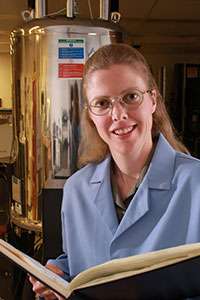Wendy Shaw wrote a comprehensive review article on outer coordination spheres.
(Phys.org) —Once dismissed as shrubbery, experimental and computational research shows the outer coordination sphere greatly influences a catalyst's effectiveness, according to Dr. Wendy Shaw at Pacific Northwest National Laboratory in her invited review article. The outer coordination sphere is the complex structure that wraps around the catalyst's central active site and controls the activity, selectivity and specificity of the catalyst. Shaw's Catalysis Reviews article focuses on bottom-up design research. In this approach, aspects of the outer coordination sphere are added as needed.
"The advantage is that you can add just the features you need to get the effects you want," said Shaw.
In her article, Shaw explores studies of a minimal outer coordination sphere based on amino acids. She goes beyond these simple arrangements to examine structured peptide use. These more complex structures allow scientists to add specific positioning of an amino acid near the active site to change the molecular properties at the metal, controlling the catalyst's behavior. She also examines the newer area of enzyme mimics. She notes several exciting studies are using computers to design enzymes from scratch that catalyze reactions that aren't found in nature.
Looking back at the 61-page review, with 226 references, she notes that many of the catalysts fall into two categories: those that function but have undefined outer coordination spheres and those that do not work but have rigorously defined spheres. Few, such as a PNNL rhodium-based catalyst, perform the task at hand and have defined structures. For her, the takeaway message is the large influence that changes far from the active site can exert over the reactivity of the catalyst, and the power of integrating computational chemistry and experimentation to create functional and structurally characterized catalysts.
More information: Shaw WJ. 2012. The Outer-Coordination Sphere: Incorporating Amino Acids and Peptides as Ligands for Homogeneous Catalysts to Mimic Enzyme Function. Catalysis Reviews 54(4):489-550. DOI: 10.1080/01614940.2012.679453
Provided by Pacific Northwest National Laboratory





















